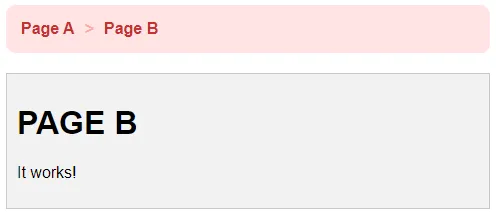Welcome to a tutorial on how to create an AJAX-driven breadcrumb navigation menu. A breadcrumb menu is easy to create, and an “AJAX breadcrumb menu” is not that difficult either – Read on for the example!
TABLE OF CONTENTS
DOWNLOAD & NOTES
Here is the download link to the example code, so you don’t have to copy-paste everything.
EXAMPLE CODE DOWNLOAD
Just click on “download zip” or do a git clone. I have released it under the MIT license, so feel free to build on top of it or use it in your own project.
SORRY FOR THE ADS...
But someone has to pay the bills, and sponsors are paying for it. I insist on not turning Code Boxx into a "paid scripts" business, and I don't "block people with Adblock". Every little bit of support helps.
Buy Me A Coffee Code Boxx eBooks
QUICKSTART – HOW TO USE
<!-- (A) LOAD CSS + JS -->
<link rel="stylesheet" href="breadcrumb.css">
<script src="breadcrumb.js"></script>
<!-- (B) WRAPPERS -->
<nav id="demoMenu"></nav>
<div id="demoWrap"></div>
<!-- (C) ATTACH -->
<script>
// (C1) CREATE BREADCRUMB INSTANCE
var bread = breadify({
menu : document.getElementById("demoMenu"),
wrap : document.getElementById("demoWrap")
});
// (C2) ADD BREADCRUMB(S)
bread.add("Page A", "pageA.html");
bread.add("Page B", "pageB.html");
bread.go();
</script>
For those who just want to use this as a “plugin”:
- (A) Load the CSS and Javascript, Captain Obvious at your service.
- (B) Create 2 HTML wrappers – One for the breadcrumb menu and another for the content.
- (C1) Call
var bread = breadify({ menu:TARGET, wrap:TARGET })to initialize the breadcrumb menu. - (C2) Use
bread.add(NAME, URL)to add a crumb, don’t forget to callbread.go()to load the last crumb.
HOW IT WORKS
With that, let us now move into more details – For you guys who want to customize or learn more.
PART 1) BREADCRUMB “INIT”
function breadify (instance) {
// (A) PROPERTIES + SET CSS
instance.loading = false; // currently loading
instance.crumbs = []; // breadcrumbs
instance.menu.className = "breadcrumb red"; // change the theme color if you want
// ...
// (D) DONE!
return instance;
}You already know breadify() from the quickstart above – This function creates the breadcrumb instance. The first thing that happens in Javascript, is to attach some flags and set the CSS.
intance.loadingAJAX is asynchronous. We will use this flag to “lock” the menu when a page is loading, unlock and allow more actions only when the loading is complete.instance.crumbsAn array to contain the crumbs.- There is nothing much about the CSS – It’s just cosmetics.
PART 2) ADDING CRUMBS
// (B) ADD A CRUMB
instance.add = (name, url) => { if (!instance.loading) {
let c = document.createElement("div"),
i = instance.crumbs.length;
c.innerHTML = name;
c.onclick = () => instance.go(i);
instance.crumbs.push({ c : c, u : url });
instance.menu.appendChild(c);
}};As in the quick start above, we call instance.add() to create a new breadcrumb. This should be self-explanatory:
- Take note of
instance.loading– We cannot add a new crumb when a page is loading. This is to prevent confusion and messing things up. - Create an HTML
<div>crumb. - Push it into the
instance.crumbsarray and insert it into the HTML menu.
PART 3) LOADING A CRUMB
// (C) AJAX LOAD CRUMB
instance.go = i => { if (!instance.loading) {
// (C1) WHICH CRUMB TO LOAD?
let len = instance.crumbs.length - 1;
if (len<0 || i==len) { return; } // stop if error or user select last crumb
if (isNaN(i)) { i = len; } // none - load last crumb
if (i<0 || i>len) { i = len; } // prevent error - load last crumb
// (C2) FETCH URL
instance.loading = true; // "lock" until loaded
fetch(instance.crumbs[i]["u"])
.then(res => res.text())
.then(txt => instance.wrap.innerHTML = txt)
.catch(err => console.error(err))
.finally(() => {
for (j=i+1; j<=len; j++) { instance.crumbs[j]["c"].remove(); }
instance.crumbs = instance.crumbs.slice(0, i+1);
instance.loading = false; // unlock
});
}};Finally, instance.go() is called when the user clicks on a crumb (or we call it manually to load the last crumb). This bit may be a little intimidating to beginners, but straightforward nonetheless.
- (C1) Determines which crumb to load.
if (len<0)Error handling – If there are no crumbs, there is nothing to load.if (i==len)If the user clicks on the last crumb, there’s no need to reload.if (isNaN(i))As in the above quick start, load the last crumb when we callinstance.go().if (i<0 || i>len)Error handling for choosing an invalid crumb, just load the last crumb.
- (C2) Load the selected crumb.
instance.loading = trueLock the breadcrumb menu when the page is loading.- Self-explanatory, put the loaded content into the specified HTML wrapper.
- Lastly, update the breadcrumb trail and unlock the menu.
EXTRAS
That’s all for this project, and here is a small section on some extras and links that may be useful to you.
GENERATED BREADCRUMB MENU HTML
<nav id="demoMenu" class="breadcrumb red">
<div>Page A</div>
<div>Page B</div>
</nav>This is the HTML that is generated by Javascript – Simple enough?
LINKS & REFERENCES
- AJAX Examples With PHP – Code Boxx
- HTML CSS Breadcrumb – Code Boxx
- Fetch – MDN
THE END
Thank you for reading, and we have come to the end of this guide. I hope that it has helped you with your project, and if you want to share anything with this guide, please feel free to comment below. Good luck and happy coding!

Dear Code Box,
I don’t see your full functionality of your demo breadcrumb.
The better idea you should have a video demo how to make it works after downloading.
I don’t know how to make it works after download.
The most important of the reader is the result of what they want.
However thank you very much for nice preparation on your blog.
OK.
https://code-boxx.com/faq/#nodemo
https://code-boxx.com/faq/#help
https://code-boxx.com/faq/#notwork